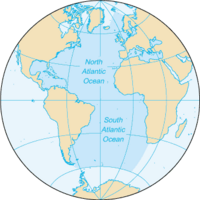
Photo from wikipedia
A large-scale permanent ocean-bottom seismograph network, named S-net, has been established in the Japan Trench area and consists of 150 observatories equipped with seismometers and tsunamimeters. Most stations at water… Click to show full abstract
A large-scale permanent ocean-bottom seismograph network, named S-net, has been established in the Japan Trench area and consists of 150 observatories equipped with seismometers and tsunamimeters. Most stations at water depths <1500 m were buried to a depth of about 1 m while they were sited freely on the seafloors at greater water depths. To understand the characteristics of strong ground motions on the offshore area, we compared the horizontal vector peak ground accelerations (PGA), peak ground velocities (PGVs), and acceleration response spectra (ARS) between the land and S-net sites for nine earthquakes (5.3≤Mw≤7.1) using ground-motion prediction equations developed for Japan. We found that the observed values of PGAs and short-period (<0.5 s) ARS were generally similar between the land and S-net sites, whereas the PGVs and ARS for the periods longer than 0.5 s were apparently larger at the S-net sites. These results based on data covering a wide area on the seafloors were generally similar to the previous results based on limited ocean-bottom stations. However, analysis of the residuals, within the source-to-site distance of 200 km, revealed that the residual values were smaller in the shallow water region compared to those toward the Japan Trench, which is characterized by proximity to high Qs in the Pacific plate, the presence of thick unconsolidated sediments on the upper crust, and increasing heights of water columns. The difference of station settings in the shallow and deep water regions may also have contributed to the biased distribution of residuals at the short periods. Quantifications of these results are expected to contribute to the predictions of ground motions for earthquake early warning and seismic demand analysis of offshore facilities and await further analysis of a larger data set.
Journal Title: Bulletin of the Seismological Society of America
Year Published: 2021
Link to full text (if available)
Share on Social Media: Sign Up to like & get
recommendations!